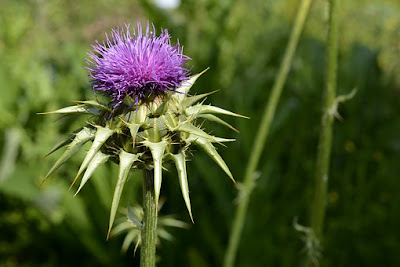Scientific name: Hawthorn - Crataegus oxyacantha; Smooth Hawthorn - Crataegus laevigata;
Common hawthorn - Crataegus monogyna; Chinese Hawthorn - Crataegus pinnatifida
Other names: Oneseed or single-seed hawthorn(common hawthorn), white horn, hawberry, May-tree, thornapple, mayblossom, whitethorn, hagthorn, cheese Tree
Description:
Common hawthorn - Crataegus monogyna is a small flowering tree or shrub that is native to temperate regions of Europe, North America, North Africa and Western Asia. It has abundant red berries and its seeds are readily spread into open fields, grasslands and woodlands, thus creating a thorny thicket. The leaves are long and broad and has 3 to 7-lobed that looks like mittens or paws. The petals are white and sometimes pinkish. The stem is filled with 1-3cm thorns. The fruit, also known as, haw is berry-like and looks like cherries or stones of plums and is brilliant red in color.
The dried haws are made into tablets or capsules.
Parts Used: Dried haws or fruits
Nutritional Benefits and Properties:
Hawthorns are rich in Vitamins C and B-complex.
Hawthorn in general contains amyddalin, flavonoids(vitexin, rutin, quercetin, and hyperoside), flavone-C, flavone glycosides, tannins, catechins, oligomeric proanthocyanidins (epicatechin, procyanidin, and procyanidin B-2), triterpene acids (such ursolic acid, oleanolic acid, and crataegolic acid), polyphenols, saponins, hyperoside, cardiotonic amines and phenolic acids (caffeic acid, chlorogenic acid, and phenolcarboxylic acids). These chemical constituents have beneficial effects and antioxidant properties.
Flavonoid acts as a natural ACE inhibitoris know to convert angiotensin (angiotensin I) into the active vasoconstrictor (angiotensin II). It widens the arteries and increases the supply of oxygen to the heart.
The bioflavonoids are known to benefit the circulatory system of the by toning and strengthening the muscles of the walls of the arteries which helps prevent aneurism & stroke.
Medicinal Properties and Uses:
Several species of hawthorn have been used in traditional medicine. The ripe fruit and flowers are usually used in herbal medicine.
Heart Problems
Hawthorn is widely known for the treatment of various heart diseases such as angina pectoris as well asatherosclerosis, chest pain, stroke, high blood pressure, stress....
It increases the supply of oxygen to the heart and is effective in increasing the amount of blood per heart beat. It is known to strengthen the heart muscles and dilate the coronary blood vessels. It also lowers blood pressure and reduce the amount of stress place in the heart by inhibiting the angiotensin converting enzyme. Hawthorn also has antioxidants that protect against the formation of plaque(prvents atherosclerosis) and lowers the LDL (poor) cholesterol.
Indigestion
Hawthorn was used in quite a few Chinese medicines to help with the retention of meals inside the belly. Hawthorn’s capabilities to break up fat also causes it to be useful for helping with indigestion that comes on as a result of eating greasy foods.
Other benefits:
Mild diuretic
Astringent quality (relief of sore throat)
Indigestion
Insomnia (fresh hawthorn is best used for this and is made into tea)
Weight loss ( hawthorn reduce the amounts of cholesterol in the body and increases the metabolic process)
Precaution and Side Effects of Hawthorn Berry
Hawthorn should be taken at recommended doses over the short term. Using hawthorn may cause headaches, nausea, vertigo, rashes and palpitations. While overdose may cause cardiac arrhythmia and it may lower the blood pressure at a dangerous level.
Just like in any part of this blog, it is still best to consult your physician before taking medicinal plants/herbs or any medications.






